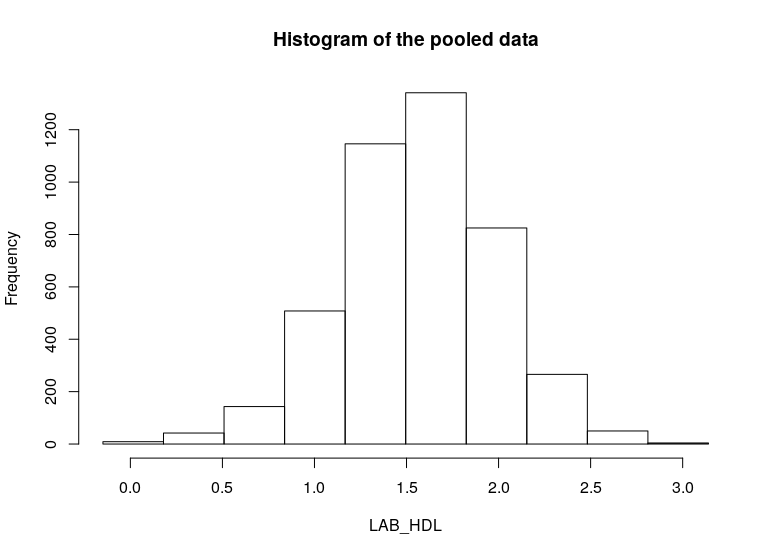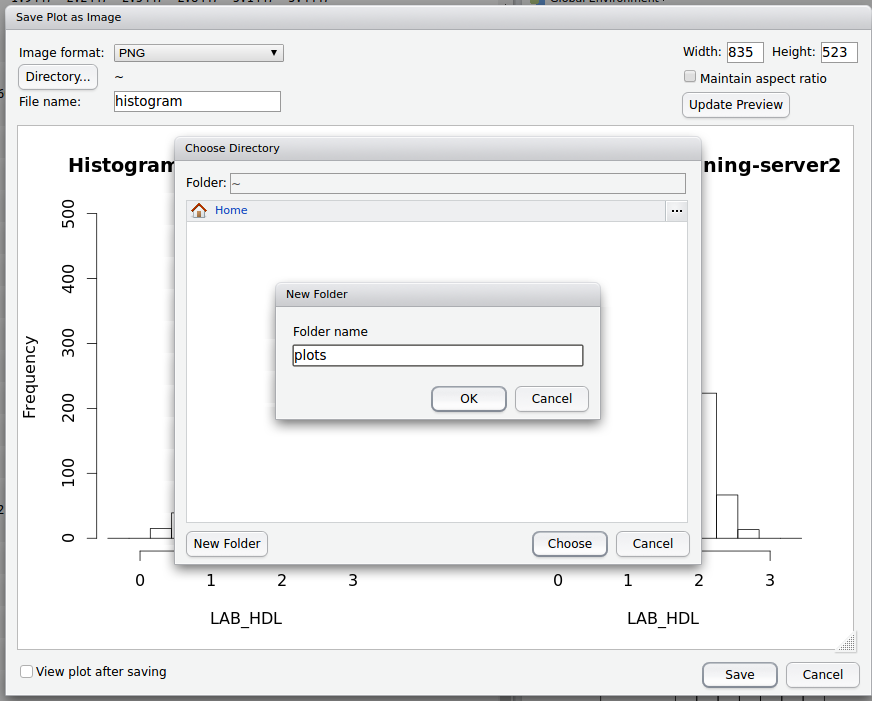It is recommended that you familiarise yourself with R first by sitting our Introduction to R tutorial. It also requires that you have the DataSHIELD training environment installed on your machine, see our Installation Instructions for Linux, Windows, or Mac. |
DataSHIELD support is freely available in the DataSHIELD forum by the DataSHIELD community. Please use this as the first port of call for any problems you may be having, it is monitored closely for new threads. DataSHIELD bespoke user support and also user training classes are offered on a fee-paying basis. Please enquire at datashield@newcastle.ac.uk for current prices. |
This is the fourth in a 6-part DataSHIELD tutorial series.
The other parts in this DataSHIELD tutorial series are:
5: Subsetting
6: Modelling
Start R/RStudioLoad Packages
Build your login dataframe
|
It is currently possible to produce 4 types of graphs in DataSHIELD: histograms, contour plots, heatmap plots and scatter plots.
In the default method of generating a DataSHIELD histogram outliers are not shown as these are potentially disclosive. The text summary of the function printed to the client screen informs the user of the presence of classes (bins) with a count smaller than the minimal cell count set by data providers. Note that a small random number is added to the minimum and maximum values of the range of the input variable. Therefore each user should expect slightly different printed results from those shown below: |
ds.histogram
function can be used to create a histogram of
LAB_HDL
that is in the assigned variable dataframe (named "DST", by default). The default analysis is set to run on separate data from all studies. Note that Study 1 contains 2 invalid cells (bins) - those bins contain counts less than the data provider minimal cell count.ds.histogram(x='DST$LAB_HDL', datasources = connections) |
Aggregated (exists("DST")) [=============================================================] 100% / 0s
Aggregated (classDS("DST$LAB_HDL")) [====================================================] 100% / 0s
Aggregated (histogramDS1(DST$LAB_HDL,1,3,0.25)) [========================================] 100% / 0s
Aggregated (histogramDS2(DST$LAB_HDL,10,-0.153421749557465,3.0579610811785,1,3,0.25)) [==] 100% / 0s
Warning: study1: 2 invalid cells
Warning: study2: 0 invalid cells
[[1]]
$breaks
[1] -0.1534217 0.1677165 0.4888548 0.8099931 1.1311314 1.4522697 1.7734079 2.0945462 2.4156845 2.7368228
[11] 3.0579611
$counts
[1] 0 18 51 172 443 550 387 153 25 0
$density
[1] 0.00000000 0.03108742 0.08808103 0.29705758 0.76509598 0.94989343 0.66837956 0.26424308 0.04317697 0.00000000
$mids
[1] 0.007147392 0.328285675 0.649423958 0.970562241 1.291700524 1.612838807 1.933977090 2.255115373 2.576253657
[10] 2.897391940
$xname
[1] "xvect"
$equidist
[1] TRUE
attr(,"class")
[1] "histogram"
[[2]]
$breaks
[1] -0.1534217 0.1677165 0.4888548 0.8099931 1.1311314 1.4522697 1.7734079 2.0945462 2.4156845 2.7368228
[11] 3.0579611
$counts
[1] 9 19 83 275 604 769 545 182 42 5
$density
[1] 0.01106408 0.02335750 0.10203539 0.33806906 0.74252258 0.94536402 0.66999140 0.22374025 0.05163237 0.00614671
$mids
[1] 0.007147392 0.328285675 0.649423958 0.970562241 1.291700524 1.612838807 1.933977090 2.255115373 2.576253657
[10] 2.897391940
$xname
[1] "xvect"
$equidist
[1] TRUE
attr(,"class")
[1] "histogram" |
type='combine'
is used.ds.histogram(x='DST$LAB_HDL', type = 'combine', datasources = connections) |
Aggregated (exists("DST")) [=============================================================] 100% / 0s
Aggregated (classDS("DST$LAB_HDL")) [====================================================] 100% / 0s
Aggregated (histogramDS1(DST$LAB_HDL,1,3,0.25)) [========================================] 100% / 0s
Aggregated (histogramDS2(DST$LAB_HDL,10,-0.153421749557465,3.0579610811785,1,3,0.25)) [==] 100% / 0s
$breaks
[1] -0.1534217 0.1677165 0.4888548 0.8099931 1.1311314 1.4522697 1.7734079 2.0945462 2.4156845 2.7368228
[11] 3.0579611
$counts
[1] 9 37 134 447 1047 1319 932 335 67 5
$density
[1] 0.003688026 0.018148307 0.063372138 0.211708879 0.502539521 0.631752481 0.446123653 0.162661110 0.031603113
[10] 0.002048903
$mids
[1] 0.007147392 0.328285675 0.649423958 0.970562241 1.291700524 1.612838807 1.933977090 2.255115373 2.576253657
[10] 2.897391940
$xname
[1] "xvect"
$equidist
[1] TRUE
$intensities
[1] 0.003688026 0.018148307 0.063372138 0.211708879 0.502539521 0.631752481 0.446123653 0.162661110 0.031603113
[10] 0.002048903
attr(,"class")
[1] "histogram" |

Contour plots are used to visualize a correlation pattern.
ds.contourPlot
is used to visualise the correlation between the variables
LAB_TSC
(total serum cholesterol and
LAB_HDL
(HDL cholesterol). The default is
type='combined' - the results represent a contour plot on pooled data across all studies:ds.contourPlot(x='DST$LAB_TSC', y='DST$LAB_HDL', datasources = connections) |
Aggregated (exists("D")) [=============================================================] 100% / 0s
Aggregated (exists("D")) [=============================================================] 100% / 0s
Aggregated (classDS("D$LAB_TSC")) [====================================================] 100% / 0s
Aggregated (classDS("D$LAB_HDL")) [====================================================] 100% / 0s
Aggregated (rangeDS(D$LAB_TSC)) [======================================================] 100% / 0s
Aggregated (rangeDS(D$LAB_HDL)) [======================================================] 100% / 0s
Aggregated (densityGridDS(D$LAB_TSC,D$LAB_HDL,TRUE,1.03336178741064,10.5673103958328,-0.1460271...
study1: Number of invalid cells (cells with counts >0 and < nfilter.tab ) is 63
study2: Number of invalid cells (cells with counts >0 and < nfilter.tab ) is 74 |
An alternative way to visualise correlation between variables is via a heat map plot.
ds.heatmapPlot
is applied to the variables
LAB_TSC
and
LAB_HDL
:ds.heatmapPlot(x='DST$LAB_TSC', y='DST$LAB_HDL', datasources = connections) |
Aggregated (exists("DST")) [=============================================================] 100% / 0s
Aggregated (exists("DST")) [=============================================================] 100% / 0s
Aggregated (classDS("DST$LAB_TSC")) [====================================================] 100% / 0s
Aggregated (classDS("DST$LAB_HDL")) [====================================================] 100% / 0s
Aggregated (rangeDS( DST$LAB_TSC )) [====================================================] 100% / 0s
Aggregated (rangeDS( DST$LAB_HDL )) [====================================================] 100% / 0s
Aggregated (densityGridDS(DST$LAB_TSC,DST$LAB_HDL,TRUE,1.03336178741064,10.5673103958328,-0.1460271...
study1: Number of invalid cells (cells with counts >0 and < nfilter.tab ) is 63
study2: Number of invalid cells (cells with counts >0 and < nfilter.tab ) is 74 |
The functions |
plot tabexport > save as image 


The other parts in this DataSHIELD tutorial series are:
Also remember you can:
|